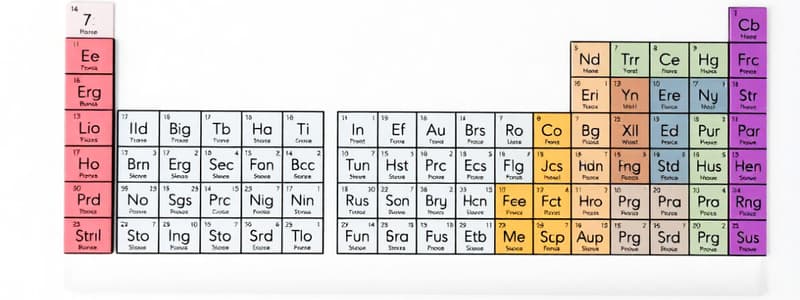Podcast
Questions and Answers
What characteristic is true for elements in the same group of the periodic table?
What characteristic is true for elements in the same group of the periodic table?
- They have similar chemical properties. (correct)
- They have identical atomic numbers.
- They all have the same number of neutrons.
- They are all metals.
Which type of bond involves the transfer of electrons?
Which type of bond involves the transfer of electrons?
- Covalent bond
- Ionic bond (correct)
- Metallic bond
- Hydrogen bond
Which of the following groups contains elements that typically form diatomic molecules?
Which of the following groups contains elements that typically form diatomic molecules?
- Noble gases
- Alkali metals
- Alkaline earth metals
- Halogens (correct)
How can the periodic table assist in comparing the ionization energies of elements?
How can the periodic table assist in comparing the ionization energies of elements?
Which type of bonding can be illustrated using Lewis dot structures?
Which type of bonding can be illustrated using Lewis dot structures?
Flashcards
Periodic Table Organization
Periodic Table Organization
The arrangement of elements based on their atomic structure and properties, including groups and periods.
Element Groups
Element Groups
Vertical columns in the periodic table, elements in the same group share similar chemical properties.
Ionic Bond
Ionic Bond
Chemical bond formed by the electrostatic attraction between oppositely charged ions.
Covalent Bond
Covalent Bond
Signup and view all the flashcards
Lewis Dot Structure
Lewis Dot Structure
Signup and view all the flashcards
Study Notes
Unit 3: Interactions Between Matter
-
Periodic Table Organization:
- Relate element position to group and period
- Identify metals, semimetals/metalloids, nonmetals
- Identify alkali metals, alkaline earth metals, transition metals, halogens, noble gases
- Elements in same group have similar properties
- Compare elements based on ionization energy, electron affinity, and atomic/ionic size
-
Ionic and Covalent Bonding:
- Bond formation through electron transfer (formation of positive/negative ions)
- Bond formation through electron sharing (Lewis dot structures)
- Write formulas for ionic and binary molecular compounds
Studying That Suits You
Use AI to generate personalized quizzes and flashcards to suit your learning preferences.




